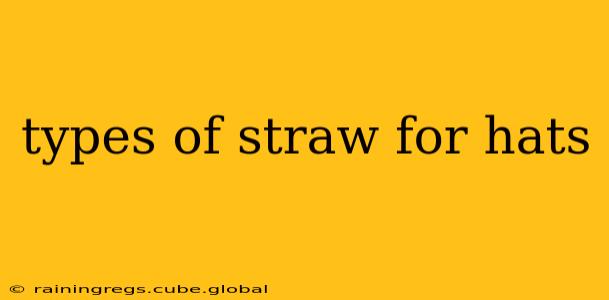Straw hats are a timeless fashion accessory, offering sun protection and a touch of elegance. But the seemingly simple straw hat hides a world of variety, depending on the type of straw used. The choice of straw significantly impacts the hat's texture, durability, and overall aesthetic. Let's explore the diverse world of straw hat materials.
What are the Different Types of Straw?
Many different plants are processed into straw for hat making. The choice often depends on factors like desired texture, durability, cost, and the hat's intended style. Here are some of the most common types:
1. Panama Straw (Toquilla Straw)
Often considered the king of straw hats, Panama straw (technically Toquilla straw) is sourced from the Carludovica palmata plant, native to Ecuador. Its fine weave creates exceptionally lightweight and breathable hats, prized for their durability and elegance. Higher-quality Panama hats boast incredibly fine weaves, sometimes with thousands of stitches per square inch. The term "Panama hat" is a misnomer, as these hats aren't actually made in Panama; however, Panama was a major export hub, hence the name.
2. Raffia Straw
Raffia is a natural fiber derived from the raffia palm. It's known for its coarse texture and natural, rustic look. Raffia hats are typically less expensive than Panama hats and often feature a more casual, bohemian style. The straw's pliable nature allows for interesting shaping and weaving techniques.
3. Paper Straw
While not technically a "straw" in the botanical sense, paper straw is a common and affordable option. Made from processed paper pulp, it's lightweight and offers a wide range of colors and textures. Paper straw hats are often used for more inexpensive and disposable styles. They're less durable than natural straw hats.
4. Seagrass Straw
Seagrass, a type of aquatic plant, is used to create hats with a distinctly natural and somewhat coarse texture. Seagrass hats are often less refined in appearance than Panama hats but possess a unique charm. Their natural texture often leads to a more casual and relaxed style.
5. Wheat Straw
Derived from wheat plants, this straw provides a relatively inexpensive and sustainable option. Its texture can vary depending on the processing, resulting in hats with different levels of refinement. Wheat straw hats are often a good balance between affordability and quality.
6. Veiled Straw
Veiled straw is a type of woven straw with a finer, more tightly bound weave. It is often used in more formal hats due to its smooth and polished appearance. It's denser and less breathable than other varieties like Panama straw.
How is the Straw Processed for Hat Making?
Regardless of the type of plant, the straw undergoes several crucial steps before it can be used in hat making:
- Harvesting: The plants are harvested at the optimal stage of growth.
- Drying: The harvested plants are carefully dried to prevent decomposition and maintain flexibility.
- Bleaching (Optional): Some straws are bleached to achieve a uniform color.
- Splitting: The stalks are often split into thinner strands for weaving.
- Weaving: Skilled artisans then weave the prepared straw into the desired shape and style of the hat.
- Finishing: The finished hat may undergo additional processes, such as blocking, shaping, and trimming.
What are the Advantages and Disadvantages of Different Straw Hats?
The choice of straw influences the hat's characteristics, influencing its price and suitability. Consider these factors:
- Panama straw: high quality, durable, lightweight, breathable, expensive.
- Raffia straw: rustic, casual, affordable, less durable.
- Paper straw: inexpensive, wide range of colors, less durable.
- Seagrass straw: natural, casual, somewhat coarse texture.
- Wheat straw: affordable, sustainable, varying texture.
- Veiled straw: smooth, refined, durable, less breathable.
Choosing the right straw for your hat depends on your desired style, budget, and level of durability you require. This guide helps you navigate the world of straw hats and appreciate the craftsmanship behind each one.
